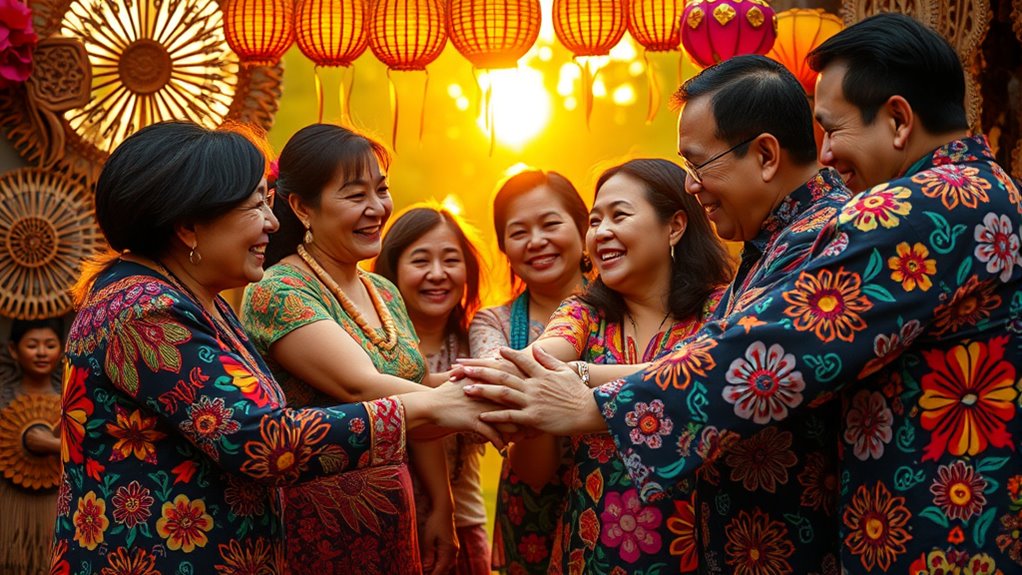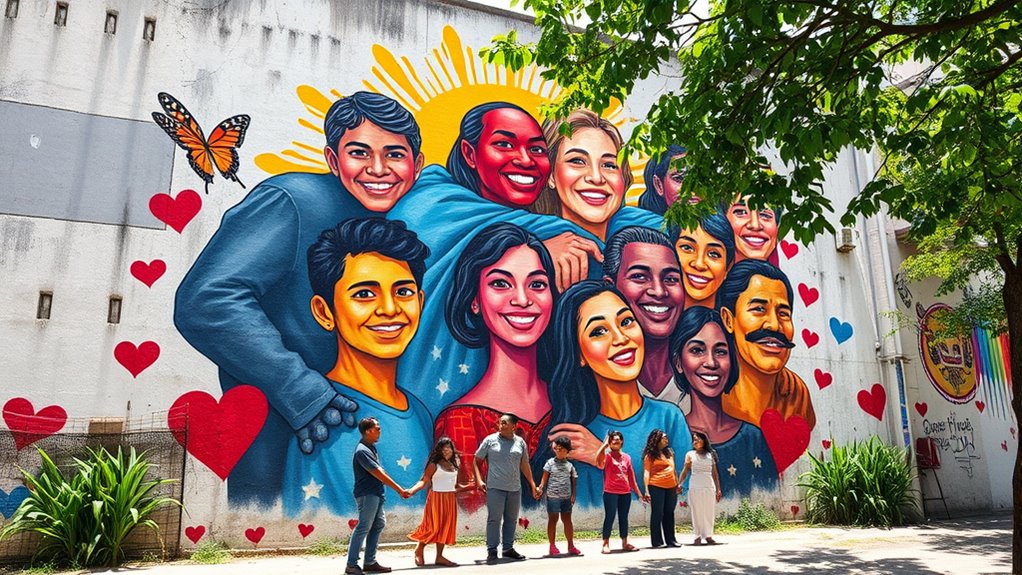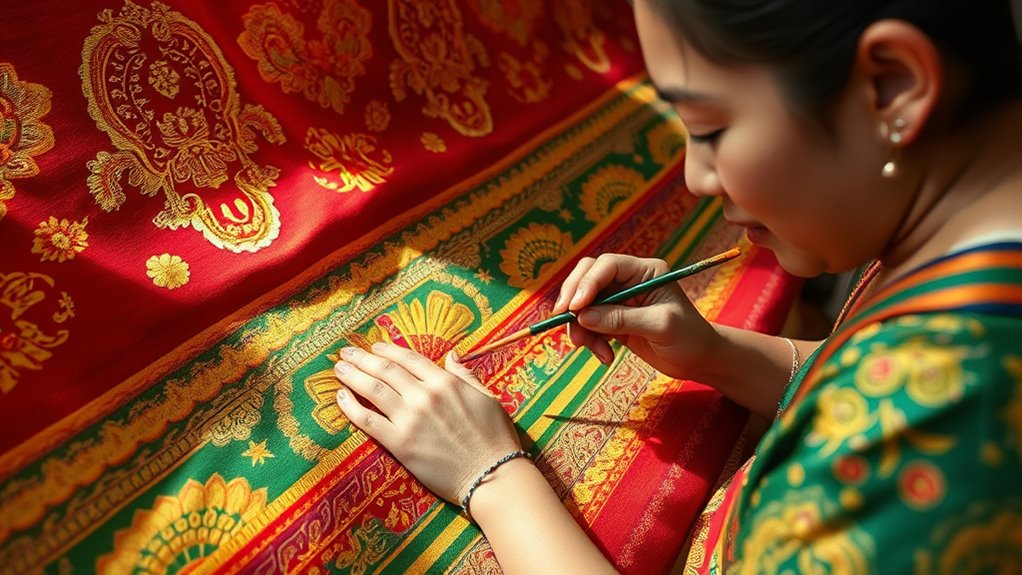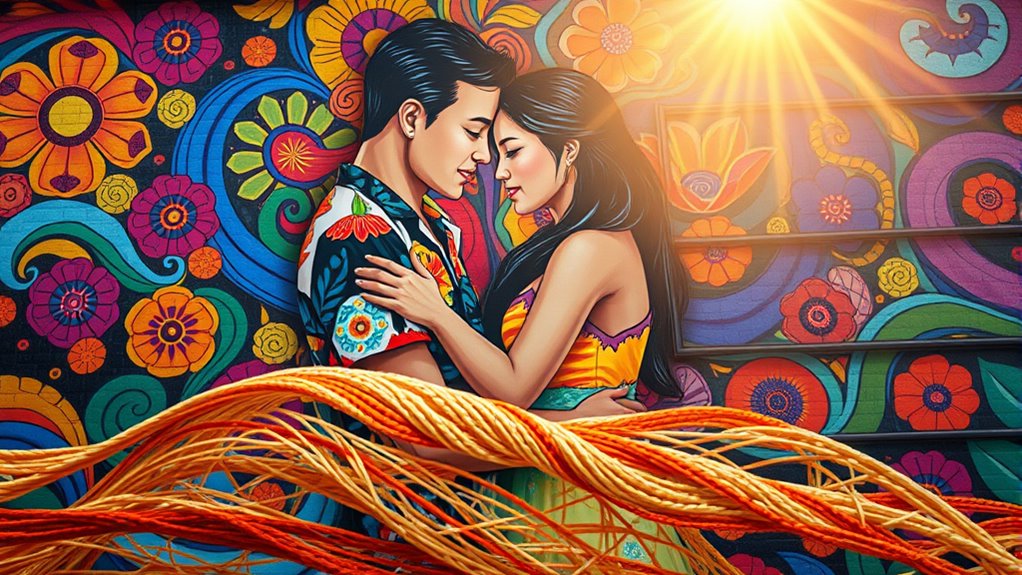Filipino art inspires love and connection by blending rich traditions with deep emotions that resonate within you. Through vibrant colors, heartfelt kundiman songs, and symbolic gestures, it captures the essence of familial bonds and romantic ties. The techniques used, from traditional dances to digital creations, celebrate relationships and foster a sense of community. Each piece tells a story of resilience and unity, inviting you to explore even more about the beauty of love expressed through art.
Key Takeaways
- Traditional Filipino art forms, like kundiman and harana, express deep emotional connections and showcase the beauty of love through music and poetry.
- Artworks often use vibrant colors and floral symbols to evoke feelings of affection and celebrate romantic and familial relationships.
- Folk festivals and performances highlight community bonds, reinforcing shared values and loyalty among individuals through collective artistic expressions.
- Sculptural and visual arts depict unity and commitment, capturing moments of love and connection in both historical and contemporary contexts.
- Digital art and social media amplify modern love stories, allowing for diverse expressions of connection and intimacy in Filipino culture.
Artistic Themes of Love in Filipino Culture

When you explore Filipino culture, you’ll find that artistic themes of love are deeply woven into its fabric. Love manifests in various forms, from the heartfelt kundiman songs that express devotion to family bonds that hold communities together.
Artists often use symbols like flowers and vibrant colors to convey emotions, creating a rich tapestry of connection. Resilience shines through, as love helps individuals navigate life’s challenges, reflecting a deep-rooted cultural significance.
Folk festivals and mythological narratives further emphasize love’s importance, intertwining it with loyalty and shared values. As you investigate Filipino art, you’ll see how these themes evolve, showing a unique blend of tradition and modernity while celebrating love in all its forms. Additionally, understanding emotional detachment can enrich our appreciation of how love is portrayed in various artistic expressions.
Traditional Filipino Love Expressions and Their Significance

Traditional Filipino love expressions carry profound significance, reflecting the values and emotions that define relationships in Filipino culture. Phrases like “Mahal kita” and “Gagawin ko ang lahat para sa’yo” highlight commitment and loyalty, essential elements of love.
Traditional Filipino love expressions reveal deep emotional connections and emphasize commitment and loyalty in relationships.
Historical influences, from Spanish to American, enrich these expressions, while literary works by writers like Francisco Balagtas shape their depth. You’ll notice that love isn’t just romantic; it extends to family, emphasizing strong familial bonds.
Expressions like “Kailangan kita” show respect and admiration, fostering community connection. Traditional courtship practices, such as serenades, remain crucial, showcasing emotional expressiveness.
Through these phrases, you experience the intertwined nature of love, culture, and community, making Filipino love truly unique and impactful.
The Role of Art in Shaping Cultural Identity

Art plays an essential role in shaping cultural identity by reflecting the rich tapestry of Filipino heritage. It brings to life the influences of pre-colonial, colonial, and post-colonial eras, helping you connect with your national identity.
Core values like personalism, loyalty, and hospitality often shine through in various artworks, emphasizing what it means to be Filipino. Artistic expressions also preserve traditions and beliefs, showcasing rituals that reinforce family ties and spirituality.
Nationalistic themes in art foster unity, while historical narratives contribute to a collective memory. As you engage with Filipino art, you promote cultural awareness and inspire future generations, ensuring the continuity of these cherished values and practices that shape who you are. Moreover, the exploration of cultural significance in art deepens your understanding of how these values are interwoven with contemporary expressions.
Techniques and Mediums Used to Express Love

While love can be expressed in countless ways, the techniques and mediums used in Filipino culture showcase a rich array of artistic forms that resonate deeply with emotions.
You’ll find traditional practices like harana, where a suitor serenades his beloved, or kundiman, a classic love song filled with heartfelt melodies.
Sculptors use materials like wood to create pieces symbolizing unity, while vivid paintings capture moments of affection.
In performance art, balak brings poetry to life, and traditional dances express romantic gestures.
Even digital art and social media now play a role in sharing love stories.
Each medium offers a unique way to convey the beauty of love, forging connections that transcend time and space.
Art’s Impact on Social Connections and Community

Expressions of love in Filipino culture not only strengthen personal bonds but also weave a tapestry of social connections within communities.
Community-based art engages local artists and residents, enhancing your cultural identity. By emphasizing collective values, art fosters collaboration, allowing everyone, even non-artists, to share their experiences and challenges.
This inclusivity builds rapport, connecting you with your neighbors through shared creative endeavors. Artistic expressions reflect your community’s values, promoting unity in diversity while empowering you to voice your thoughts.
Ultimately, community art preserves cultural heritage, ensuring that stories and traditions are passed on to future generations. Through these artistic collaborations, you strengthen social ties, creating a vibrant and connected community.
Celebrating Human Relationships Through Art

Through various artistic mediums, Filipino artists celebrate the richness of human relationships, showcasing the diverse connections that bind people together.
You’ll notice how art captures family bonds, portraying motherly love through nurturing gestures and sibling relationships through playful interactions. These pieces emphasize unity and joy during cultural celebrations.
Romantic relationships, too, come alive in art, reflecting traditional courtship rituals and modern interpretations that challenge norms.
Artists skillfully use colors and shapes to convey emotions, making you feel the intensity of these connections. Through shared memories and experiences, art highlights the importance of relationships in personal well-being, offering emotional support and preserving cultural identity.
In each piece, you find an affirmation of the beauty of human connections.
The Evolution of Love Expressions in Contemporary Art

As contemporary art evolves, it reflects the changing ways love is expressed in Filipino culture. You’ll notice vibrant colors like oranges and yellows that evoke warmth and intimacy, while metallic accents add depth.
Artists use diverse mediums, like oil and watercolor, to capture various aspects of love. Themes often center on unconditional love and lasting relationships, showcasing enduring bonds. Works like Kristine Joed Mendoza’s “Unconditional Love” pay tribute to maternal affection, emphasizing its limitless nature.
Abstract forms evoke deep emotions, while symbols convey different love types. Influenced by personal experiences and cultural heritage, these artworks create profound connections, inviting you to explore the complexities of love in contemporary Filipino art.
Frequently Asked Questions
How Can I Incorporate Filipino Art Into My Home Decor?
To incorporate Filipino art into your home decor, start by using natural textiles like t’nalak and banig for warmth.
Add wooden or bamboo furniture to showcase craftsmanship, and use capiz shells in decorative items. Bright colors and intricate patterns can bring vibrancy to your space.
Don’t forget to include cultural icons like jeepney figurines and parol lanterns for a festive touch. Handmade rugs and embroidered pillows can also enhance your decor beautifully.
What Are Some Famous Filipino Artists Who Focus on Love Themes?
Like a warm embrace, Filipino art wraps around themes of love.
You’ll find that artists like Ang Kiukok and Juan Luna explore emotions through their powerful works.
Ernest Concepcion challenges perceptions, evoking feelings with his unique style.
Even literary figures like Jose Rizal, known for his poignant sketches and poetry, capture love’s essence.
Investigating these artists can deepen your appreciation for how they portray love and connection in their creations.
Where Can I Find Exhibitions Showcasing Filipino Love-Themed Artworks?
You can find exhibitions showcasing Filipino love-themed artworks at several prominent galleries.
Check out the Sigwata Art Gallery in Santa Cruz, Manila, known for its intimate shows.
One East Asia Gallery in Singapore also features Filipino artists, often highlighting love and partnership.
If you’re looking for international exposure, the Saatchi Gallery in London frequently hosts Filipino art exhibitions.
Keep an eye on Art Trek exhibitions across Southeast Asia for more opportunities!
How Does Filipino Art Differ From Other Cultures in Expressing Love?
Did you know that 85% of Filipino artworks incorporate themes of family and community love?
Filipino art stands out from other cultures through its vibrant colors and symbolic use of natural elements, like flowers to represent enduring love. Unlike many Western artworks, which often focus on individualism, Filipino pieces emphasize strong familial bonds and community connections.
This unique expression showcases not only romantic love but also a deep-rooted sense of spirituality and patriotism.
What Role Does Social Media Play in Promoting Filipino Love Art?
Social media plays an essential role in promoting Filipino love art by providing a platform for artists like you to showcase your creations directly to a global audience.
You can connect with art enthusiasts, share your unique expressions, and engage with potential buyers instantly.
This visibility not only enhances your career prospects but also fosters a sense of community, allowing you to collaborate and inspire one another while celebrating the rich cultural themes of love.
Conclusion
In a world where technology often isolates us, Filipino art reminds you that love and connection are still alive and vibrant. Ironically, in a culture that sometimes rushes past its roots, these artistic expressions weave a tapestry of relationships that bind communities together. As you explore these works, you realize that the simplest brushstroke or melody can evoke profound emotions, proving that even in modernity, the heart yearns for the timeless language of love.









